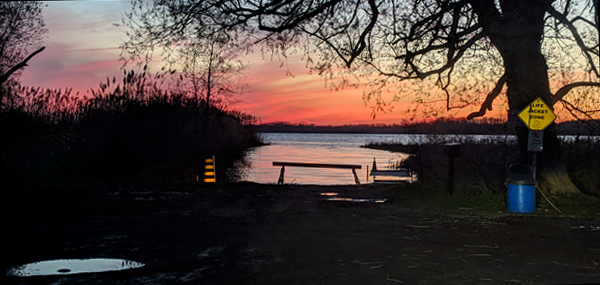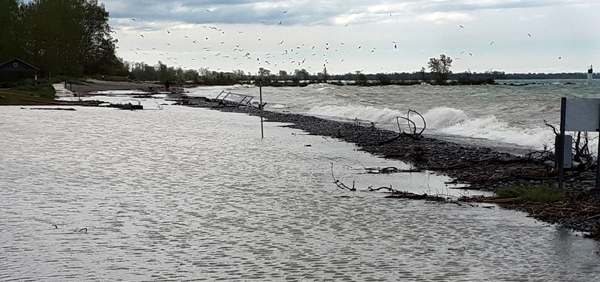County preparing for high water levels in 2020
Administrator | Dec 16, 2019 | Comments 21

Mabel Kleinsteuber Launch on County Rd 12 one of several closed in the County due to high water this summer. Sue Capon file photo
With a risk of above average water levels on Lake Ontario and the Bay of Quinte into the spring of 2020, the County of Prince Edward is proactively evaluating its response plan.
“We experienced two distinct flood situations in 2017 and 2019, and we learned a great deal both years. Based on those lessons and the current forecasts, we are preparing for all scenarios in 2020,” said Mayor Steve Ferguson. “We are currently developing plans to protect critical infrastructure and evaluating the supports we provide residents impacted by high water levels.”
The County’s Municipal Control Group has met throughout the fall to review current and forecasted water levels with Quinte Conservation and discuss preparedness measures.
Quinte Conservation water resources manager Christine McClure said the 2020 peak water level will depend on how much rainfall and snowmelt is received on Lake Ontario.
“The upper Great Lakes are near record high water levels for this time of year. The water from the upper Great Lakes ultimately drains to Lake Ontario, which also remains above average for this time of year,” she said.
Several roads in the County were flooded this past spring. Municipal staff are exploring the feasibility of building up the roads most at risk of flooding. Funding would be included in the 2020 capital budget to carry out this work.
The municipality is also evaluating its plans for distributing sandbag provisions and flood debris bins in 2020. This past spring, the County expanded the availability of sand and sandbags to 12 locations throughout the municipality. Flood debris bins were placed in six locations. Residents can share their feedback on sandbag distribution and flood debris bins by emailing info@pecounty.on.ca or by calling 613.476.2148 extension 1023 or 613.962.9108 extension 1023.
“Now is the time for residents and property owners to take precautionary measures to protect themselves and their homes in the event of flooding in 2020,” Ferguson says. “Residents are advised to consult with Quinte Conservation about new shoreline protection works.”
Ferguson and heads of communities in the Bay of Quinte region have demanded the International Joint Commission (IJC) take immediate action to reduce water levels and keep them down. They have called for the IJC to revoke the Lake Ontario – St. Lawrence River Plan 2014 and reinstate Plan 1958-DD.
The initiative has gained support from the Eastern Ontario Wardens’ Caucus and the Eastern Ontario Mayors’ Caucus. In addition to lobbying for changes to water level management, Ferguson has met with representatives from the federal and provincial governments to request that additional financial support be made available to residents and municipalities negatively impacted by flooding.
The Great Lakes–St. Lawrence River Adaptive Management (GLAM) Committee seeks input from property and business owners directly affected by the high water levels in 2019. Property owners can submit information on the extent of flooding, erosion, damage to shoreline structures, and related damage to residential and business shoreline properties. The questionnaire takes about 20 minutes to complete, depending on extent of damage being reported on.

Wellington Beach had no beach, or roadway early June 2019. – John Ferguson file photo
Filed Under: Featured Articles
About the Author:



































I believe the best way to describe what is happening now with climate change and the results of it – including the flooding of lakes and oceans can be summed up by one line – “the best laid plans of mice and men often go awry.”
Merry Christmas and New year!
There’s a major difference between denying climate change and questioning its useful application in a specific context. Indeed, it’s often struck me that invoking climate change is an easy reaction and is as much a retreat from responsibility as a call to arms. The point of my Ottawa sewer story is that McGuinty’s invocation of climate change served only political expediency. A single downpour, as even the U.N.’s latest IPCC report admits, is not necessarily evidence of climate change. In Ottawa’s case recent flooding may be related more to paving wide roads and parking lots and building monster homes on small plots of land. With little space left to absorb rainfall naturally, sewers designed for normal circumstances will back up during severe storms. Does invoking climate change help solve an engineering problem, or does it lead to wringing of hands and avoidance of responsibility?
Similarly, when comparisons are made between the Great Lakes and seaside flooding related to high tides, storm surges and Greenland’s melting icefields, how does this further an understanding of the forces at work in Lake Ontario’s flooding?
Finally, identifying cause and effect relationships are notoriously difficult because correlations are often mistaken for causation. How then does one determine whether a severe winter or Plan 2014 is responsible for Lake Ontario’s high water levels? Occam’s Razor, a principle of reasoning, provides a guide in preferring less complicated explanations that are testable. This suggests that Plan 2014 is the most likely cause of Lake Ontario’s flooding. After all, the new regulatory plan has not exactly proven itself as effective during two of the past three years. Returning to the old plan, or slight modification, would be a simple way of verifying the hypothesis.
I know that countylive commenters delight in speculations, but sometimes things are not complicated.
I’m sure most readers acknowledge that climate change plays some role – as yet perhaps not completely understood – in the flooding of Lake Ontario. However, many have issues with the IJC, while acknowledging they are not solely responsible for the problems and are not the sole solution.
The IJC’s raison d’etre is to facilitate Great Lakes shipping, as much and as cheaply as possible; high lake levels make this attainable. This is followed by facilitating hydro power generation. Problems arising for shoreline dwellers by flooding – not their concern! One clear issue is that the IJC seems to be sorely lacking in transparency – I can find no record of their meetings that would shed some light on reasoning for the positions they took earlier this year.
Clearly stinging from criticism of their Plan 2014, they steadfastly refused to use the tools available to them to maximize the release of water from Lake Ontario. Instead they blamed everything on climate change. Again, because there is no public record of their decisions, I assume that they finally, reluctantly bowed to political pressure.
The IJC needs to recognize that while they are not solely responsible, and cannot completely solve the flooding problem, they are an inegral part of the solution. They must work together with all levels of government in a transparent manner, as efforts are made to mitigate the effects of climate change. Denial is no longer acceptable.
What did Montreal ever do prior to water being controlled going down the St Lawrence?
Another concern the IJC has to consider: “The board must balance numerous and competing interests, including shoreline owners along Lake Ontario, but also the 1.8 million residents of Montreal. Letting out enough water to reduce Lake Ontario by 1 inch raises the level of the St. Lawrence at Montreal by 11 inches.”from May 2019 NYup.com
This discussion is no longer dealing in reality – the Great Lakes are the largest bodies of fresh water in the world – they are often referred to as “fresh water oceans.” But regardless of their geography or what name is given to them they are still flooding and a number of communities fronting on them are flooding just as the ones on the oceans are. The fact is, the Great Lakes are at historic high levels – and more is still expected. There is no point in denying what is happening, so blaming a monitoring committee for the high levels is inaccurate and futile – just as comparing what happened to Ottawa’s sewer system as being comparable to this. As I suggested before – this is a complicated matter and it will definitely take more than simply opening up the dams.
A geography refresher: Venice, Key West, Miami and Canada’s East Coast communities are all on oceans. Lake Ontario has a managed water control plan, which is supposed to mitigate the effects of fluctuating water levels.
The invocation of climate change reminds me of one of Premier Dalton McGuinty’s silliest comments. Many years ago Ottawa suffered widespread flooding from a downpour. McGuinty opined it was an example of climate change rather than attributing it to Ottawa’s faulty storm sewer system.
The point I am making is that if one is looking for a solution it’s not in appeasing the climate gods or faulting people for building or purchasing houses in floodplains. Until a few years ago the IJC seemed to be able to control high water. Now it can’t. What is so hard about expecting the IJC to manage water levels? Outflows from the upper Great Lakes take a long time to reach Lake Ontario. It’s not as if there is no advance warning. Of course, the new plan privileges the interests of shipping and hydro electricity generation over lakeside residents and communities. What a costly mismatch of priorities!
As I asked before – what information was the IJC using to base the 2014 PLan on? Right now what we do know is, we have the country to the south of our border who has environmental policies that do not recognize climate change nor global warming – this is who Canada has to negotiate with, plus our own provincial government has stripped away many of our environmental safeguards, plus Ford has reduced the budget and the role for Conservation Authorities – compounding all of this is the fact that municipalities have allowed building in flood zones for many years, we have created our own “perfect storm” – scary isn’t it? I can only wish waterfront owner good luck. This is not a simple problem to solve and nor is PEC alone with this problem – just ask the people in Venice or in Key West, Miami and in some of Canada’s East Coast communities. This is certainly a global warming and climate change problem – and the IJC cannot be blamed for not being able to predict what the future may hold. As for not reacting faster – I have no idea what factors they need to take into consideration before changing the outflow of the dams on the St. Lawrence. Do any of the readers of this article have any insight into this situation?
In the Greater Montreal Area, I understand that homes have been built in flood zones and have suffered high water damage from both the Ottawa and St. Lawrence rivers. However, on Big Island (and perhaps elsewhere in the County) houses are well back from the water, and damage has been limited to shorelines and roads. Hence, the building decisions of waterfront home owners and the municipal government are not relevant.
What is relevant—the vagaries of Nature or the actions of the IJC? It’s a curious coincidence that no flooding of this magnitude occurred before the adoption of the new regulatory plan, which was supposed to improve management of water levels. If the plan can’t handle annual variations in water flow, it isn’t exactly improved management.
Although unpredictable weather and poor zoning may play some part in the problem, a good plan should have the flexibility to respond to unusual circumstances. I wonder whether the old plan would have caused as much damage.
Questions about zoning and climate change just help the IJC to avoid taking responsibility.
The public dock in Northport has been disabled since 2017, and this year’s flooding pretty much destroyed what could have been saved. However, the very nature of docks and their relationship to water is obviously much different than what residential properties experience – so seeing a dock destroyed is not uncommon, seeing a house destroyed is another matter. What I asked about was the impact that municipally approved residential building in “recognized” flood zones has had on the amount of damage that has been experienced over the last few years. I would imagine that regardless of where you live, your house had to receive municipal building approval – whether on the mainland or on an island. To suggest that municipalities don’t have a level of responsibility for their approved building and zoning, is faulty reasoning. I don’t believe anyone commenting on this topic has suggested that any group of residents nor any level of government is to blame for the flooding. But it is a fact that municipalities have allowed building to take place within flood zones and have done so for many years. Both the homeowner and the municipality gambled that flooding would not happen.
What I have been trying to discover, is what information did the IJC use to create the 2014 Plan? From the various articles that I have read – what we are experiencing is like “the perfect storm” – several years of unusually large amounts of rain and then heavy snow melt, hot summers with low water tables, – the long and the short of all of this is the 2014 Plan could not have predicted this – but the solution to this problem is far more than just asking the IJC to open up the dams more on the St. Lawrence River. From the man made problems that the St. Lawrence Seaway has created to the impact of climate change -what waterfront property owners need to ask is – what to do if this trend continues? BTW, this question is being asked around the world right now – it is not unique to PEC.
I can’t speak for other parts of the County, but on Big Island high water has rendered the boat launch useless, destroyed land along shorelines, and undermined the causeway. None of these effects has anything to do with building in flood zones, nor are island residents and county government the cause. These real problems are related to the regulation of Lake Ontario water levels. I presume the regulations benefit shipping, hydro power generation, and perhaps other interests, but at the expense of Ontario (and New York state) waterfront residents, marine businesses, and municipalities. By any cost-effect analysis the IJC is inflicting a billion-dollar disaster.
I don’t want to open a political debate over this, but to be clear, the IJC 2014 Plan was signed by the Harper government in cooperation with the Americans – I don’t see how our present MP is to blame for any of this mess. What I believe is greatly influencing the decisions on this topic of flooding is the role that municipalities played in it – both north and south of the border. In Ontario, planning decisions are a local responsibility, controlled by the provincial Planning Act. I wonder how many municipalities over the past 50 years have allowed development within the flood zones – believing that they would never flood? Obviously they were wrong. I find it interesting that it is now the municipalities that are demanding action. I wonder how many of them are now prepared to take on the costs of their planning decisions? And we all know what that would mean.
For clarification I think the other Rob below is suggesting making subtle changes on your property in contravention of what the laws are, in the name of protecting your investment when your government is unable to get anything done to help you.
Of course our great MP was mindlessly re-elected, he who proclaimed that if re-elected would work to establish a caucus or committee of members from ridings all along the affected shoreline. And of course he had to be re-elected to do this. Seems he forgot that he was the incumbent and should have done more during that time.
So far we’ve heard or seen little from his plans, but that should hardly be a surprise.
In the meantime affected homeowners dread the approach of another warm season that could be as bad or worse than any yet.
You cannot dump raw fill into the Outlet River at the mouth of East Lake without Conservation approval.
If you witness people dumping various fills into the shoreline anywhere, call your Conservation Authority and report.
Don’t call the conservation authority. Just protect your investment. Doug Ford adjusted the budgets for conservation authorities for a reason. If you keep your eyes open when you are driving around you’ll see that many people have already started working on their shorelines for this reason.
You don’t own your road allowance either, but you’d probably do something about it if it was contributing to the deterioration of your home.
To answer one of the questions asked – Canada’s “whistle blower” laws are next to non-existent. This would be a good issue for our local MP to tackle. Also, I’m not sure if the control of high water levels is as easy as it might seem. In order for shipping to travel as far inland as it does, I would think that they need a minimum depth to function in safely. PIcton Harbour is a good example – haven’t we been told in the past that the ships coming into the Terminal have only a few feet of space between them and the bottom? Could this also be a factor around the Great Lakes on both sides of the border?
Property owners do no own the shoreline. They cannot just dump any gravel or stone into the water. They must first work with and seek approvals from the local Conservation Authority.
What is really going on here? We know the IJC has the tools and experience to control the levels of the great lakes, whether you believe in global warming or not. We are being lied to and there is an agenda that is either political or from Big Business (and/or both). I wish someone could find out and publish the truth. Where are our whistle blowers?
IJC and local politics aside (they won’t help you in time), you need to start building a preparing now if you are on the water. Use the time and frozen ground this winter to sandbag or build a levy or wall to save your property. Pea gravel or crushed stone works well to control erosion temporarily.
Don’t wait for the county or province to do something. Next year is going to be the worst one yet.
Glad to read that various municipal governments are continuing to pressure the IJC to reduce the level of Lake Ontario. It would be interesting to know what is happening provincially and federally. Given the current levels of the Upper Great Lakes, depending upon the snow and rainfall we receive over the next few months, if the IJC does not continue to release the maximum amount of water from Lake Ontario as possible, we will likely see flooding on a larger scale than either 2017 or 2019.